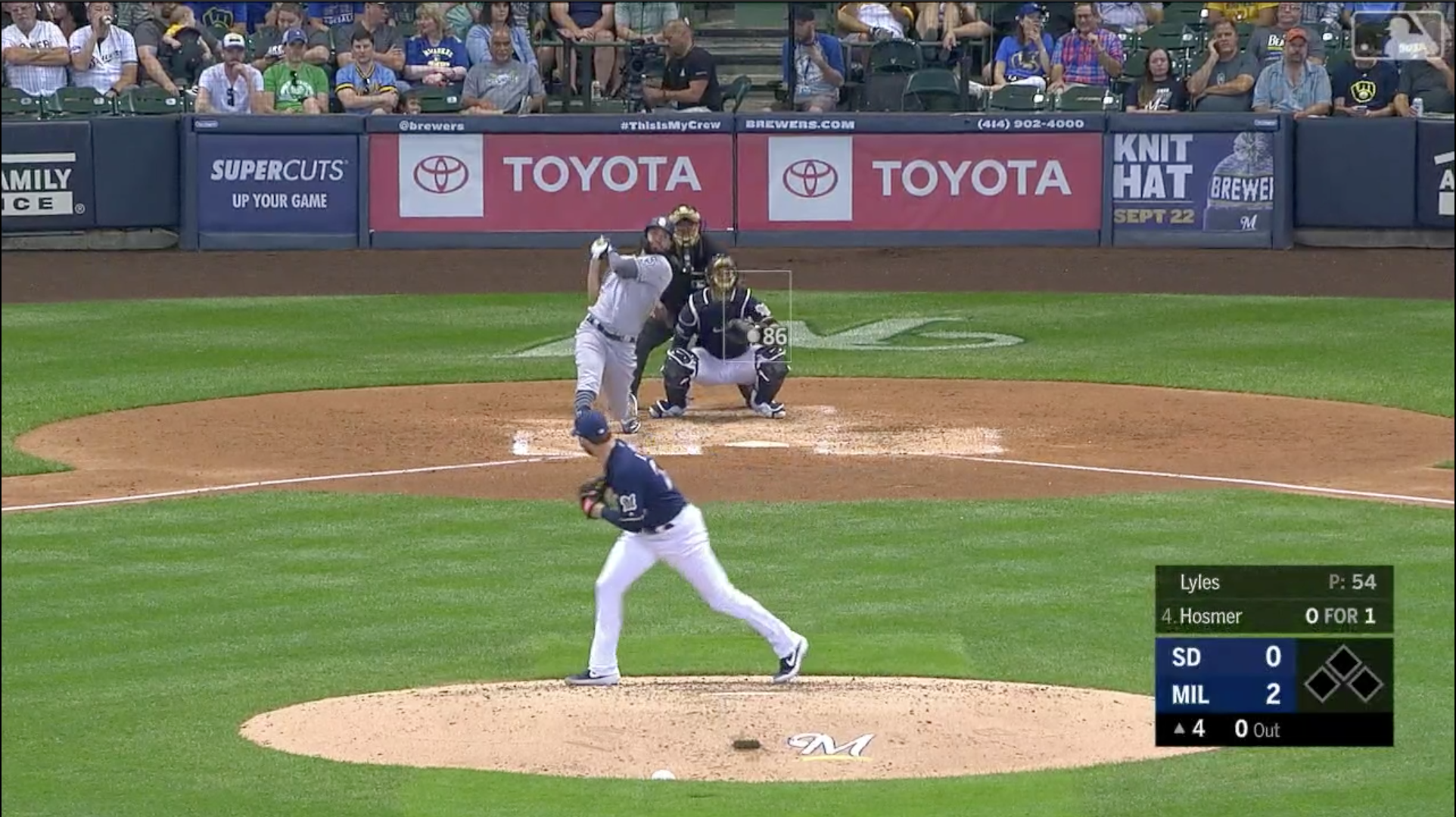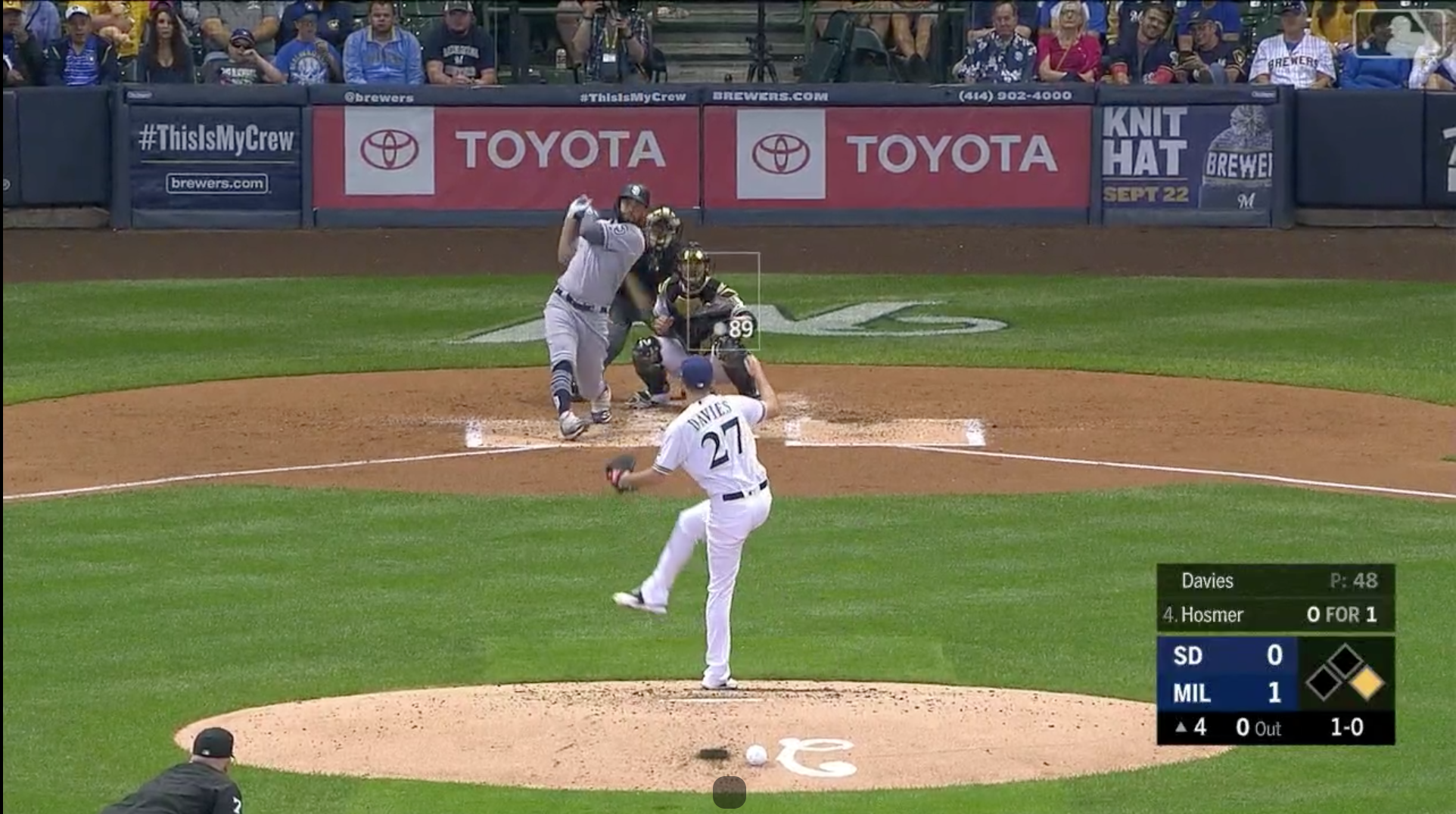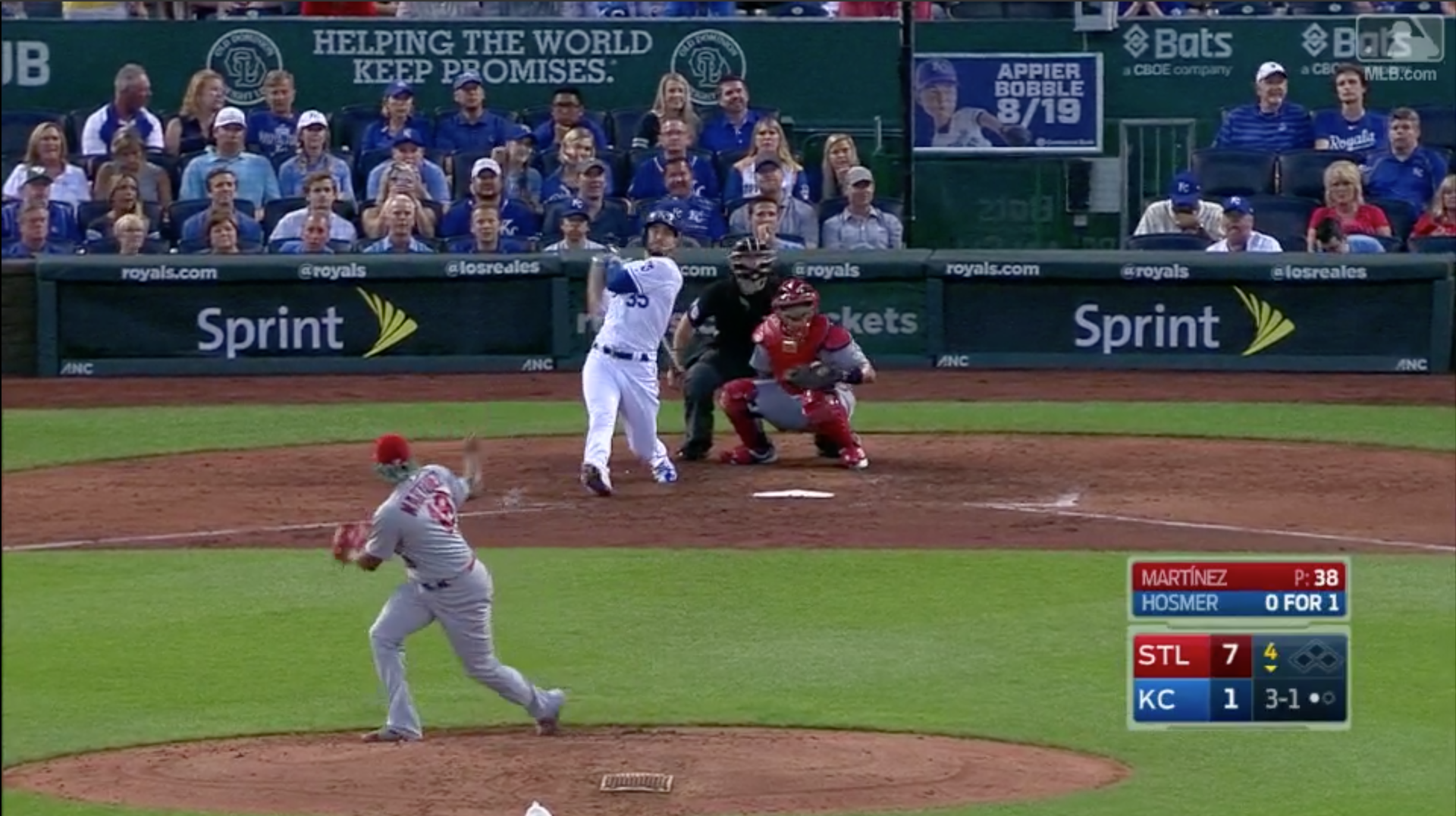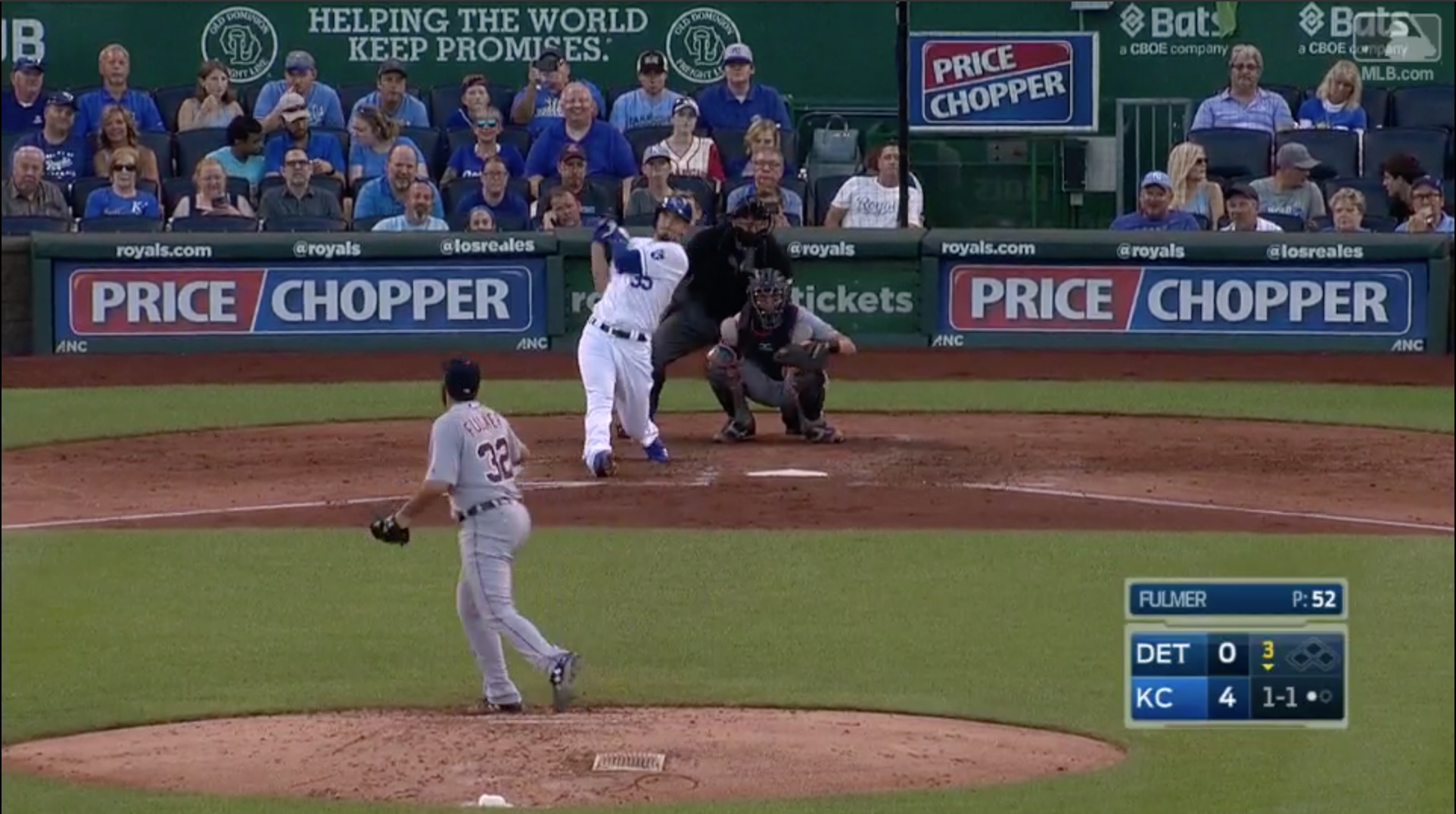When the Kansas City Royals selected Eric Hosmer third overall in the 2008 MLB draft, they knew they were getting an athletic first baseman who was going to act the part of a top prospect too—a clubhouse leader. While the production hasn’t necessarily matched the lofty expectations of a top prospect, only having three seasons of a 3.0 fWAR or higher in his career, Hosmer still was a big part of the 2015 World Series-winning Royals. When you win a World Series and are a big reason the team got there, it puts you on the map. Add that to having a career campaign in his free-agent walk year, and you’ve got yourself an eight-year $144 million deal with the San Diego Padres. What the Friars wanted was a guy who could continue being that same franchise cornerstone, banking on the improvements in production, of course, while growing with—and mentoring—the Padres’ prospects in trying to build a future winner.
Note the key words: “banking on improvements in production.” That has not happened since Hosmer got to San Diego, as he posted a 95 wRC+ in 2018 followed by a 93 wRC+ this season.
When Hosmer returns next season he’ll be entering the wrong side of the 30-year-old plateau, already showing signs of steady decline and breaking down the door of the “contract bust” label, and one can only ask: Does Hosmer still have the ability to lead an underdog franchise to another World Series title?
The Ground-Ball Epidemic Explained
The most glaring issue with Hosmer this season, besides the overall numbers, are his platoon splits.
| wRC+ | |
| v L | 66 |
| v R | 102 |
This is backed by incredibly poor batted-ball metrics in those platoon splits.
| GB% | FB% | LD% | PU% | |
| v L | 64.8 | 9.0 | 23.8 | 2.5 |
| v R | 53.9 | 20.8 | 22.9 | 2.4 |
Even though there’s a 10-point discrepancy between the two, it’s still incredibly concerning that the ground-ball percentage against righties is above 50%. Then again, Hosmer’s career batted-ball metrics look like this.
| GB% | FB% | LD% | PU% | |
| Career | 57.4 | 15.3 | 23.3 | 4.0 |
That stat line points to a much larger issue with Hosmer: He doesn’t get the ball off the ground very much. In an era that is defined by getting the ball in the air via launch angle, Hosmer does not fit that mold whatsoever.
| Avg Launch Angle | |
| 2015 | 5.5° |
| 2016 | 3.6° |
| 2017 | 3.8° |
| 2018 | -1.2° |
| 2019 | 2.2° |
Considering the decline in Hosmer’s average launch angle prior to reaching San Diego, the coaching staff probably pushed him to add a more substantial leg kick in an effort to raise it. Of course, to no avail, as that leg kick just tanked the launch angle 5 degrees.
However, Hosmer’s kept that same leg kick into this season, and the launch angle as returned, making it seem that the leg kick has really had no effect in terms of his batted ball, but rather a steady decrease in contact percentage.
| Contact% | |
| 2011-17 | 80.5 |
| 2018-19 | 73.9 |
Now, my first thought was that if Hosmer then decreases his leg kick, the contact rate would increase and he’d start to resemble the player he was before. However, the more the information sank in, I started to realize that it wasn’t like Hosmer was a beacon of offensive success when he was in Kansas City either. In his eight-year career, he’s only posted three seasons that resulted in a 120 wRC+ or higher.
As I toggled through numerous videos of Hosmer hitting, it wasn’t exactly clear at first why he did not hit better—of course, through highlight videos, one can never truly grasp the complete package.
Though throughout all those videos, the opposite-field swings of Hosmer were majestic. Hosmer’s swing is smooth and majestic by itself, but it was something about that opposite-field swing that resonated with me more than any other one of his swings.
I mean, just look at this beauty here.
This got me thinking: How are Hosmer’s numbers to the opposite field?
Remember that during his free agency, Boston was rumored to be a logical landing spot for Hosmer given his opposite-field prowess and that could’ve made the Green Monster his best friend.
This meant there had to be something to it, right? Well, lo and behold, there was something to it. Take a look at his xwOBA on contact when hitting to the respective fields.
| Pull | Straightaway | Opposite | |
| 2019 | .360 | .380 | .418 |
| Statcast Era (Since 2015 | .340 | .396 | .427 |
It’s completely counterintuitive. Someone who hits way better to the opposite field than to the pull—that’s rarely the case.
Furthermore, I decided to see what his batted balls were to each direction. Is there something that might make everyone’s head explode? The answer is yes.
Pull
| GB% | FB% | LD% | PU% | |
| 2019 | 72.0 | 8.3 | 18.2 | 1.5 |
| Career | 71.9 | 8.8 | 17.2 | 2.1 |
Straightaway
| GB% | FB% | LD% | PU% | |
| 2019 | 62.9 | 14.9 | 21.1 | 1.0 |
| Career | 57.9 | 18.7 | 20.1 | 3.3 |
Opposite
| GB% | FB% | LD% | PU% | |
| 2019 | 31.2 | 32.0 | 31.2 | 5.6 |
| Career | 33.5 | 29.1 | 28.1 | 9.4 |
Of course, this is reflected by the average launch angle when hitting to the respective sides of the field.
| Pull | Straightaway | Opposite | |
| 2019 | -5.9° | -0.4° | 15.6° |
| Statcast Era | -5.9° | 0.5° | 14.9° |
When hitting to the opposite field, Hosmer definitely plays the part of the modern-age hitter, hitting more fly balls than ground balls, whereas when he hits straightaway he roughly hits to his cumulative career norm. However, the pull metrics are the ones that truly shock me. He’s hitting nearly three out of every four pulled balls on the ground.
It’s shockingly backed by an astonishing set of launch-angle numbers too. How is it even possible to have that low of an average launch angle to any area of the field? Forget to the pull side, which is a lot of hitters’ strength.
Putting this all together, it’s easy to then think, “Great, he just needs to hit more balls to the opposite field and he’ll start producing more.” Right?
Well, not exactly. Hosmer currently hits 27.3% of his balls to the opposite field, which is the 26th-highest rate in baseball among qualified hitters—the highest being DJ LeMahieu at 33.5%. So, sure he should probably be trading off some of his poor pull and straightaway batted balls for opposite-field ones, though it would be unrealistic to expect him to really top any more than the 33.5% LeMahieu has.
With that being said, there must be something in the opposite field swing that makes him successful—possibly a trait that could make all of his batted balls better.
The Dodger School Of Hitting
Before I even started looking at the batted-ball metrics we just saw, my first reaction in seeing Hosmer’s career ground-ball rate was to theorize how he could increase that launch angle. I thought none other than Max Muncy, who’s increased his launch angle and become one of the many Dodgers who boast such a trait. In this article last year from The Ringer, the changes Muncy made into his approach, mentally and physically, were incredibly well detailed. He sat in his legs more while also hunting pitches he liked to hit and not really swing at anything else. Though the most interesting part was came from FanGraphs analyst Eric Longenhagen.
Dodgers hitters’ lower halves pic.twitter.com/M2Iz57vIvf
— Eric Longenhagen (@longenhagen) June 14, 2018
The purpose behind collapsing the backside as such is to really get into your legs through your swing, thus bringing the barrel through the zone in a way where you naturally positively impact the ball.
Now, let’s look at a couple of hard-hit balls from Hosmer this season—both recently in Milwaukee.
Like the tweet we just saw, I am going to show you still shots of Hosmer’s followthrough—notice his lower half and his body as a whole.
Unfortunately, Jordan Lyles does not seem to care about our little endeavor and has thus partially obstructed our view of Hosmer’s feet. Nevertheless, you can still see that the back leg is relatively low to the ground—but it’s still not clear which Hosmer is lower.
Let’s do some constructing. Draw an imaginary line from the top of Yasmani Grandal’s—Milwaukee’s catcher—helmet and see where it hits Hosmer’s body.
Now in the first image, that line seems to roughly intersect Hosmer’s chin—possibly the very top of the shoulder.
In the second image, that same imaginary line maybe hits the bottom of the shoulder, in line with the shoulder blade.
What does that prove? It means Hosmer is slightly more elevated in his pull swing followthrough than his opposite swing, therefore telling us how Hosmer is hitting the ball. Those couple of inches are the difference between a home run and a double, a line drive and a ground ball.
Furthermore, what makes this an apt comparison is that the pitches are in similar locations and speeds. Hosmer had different swings on each, as Lyles threw a cutter and Zach Davies threw a fastball.
To further prove the point, let’s take a couple of Hosmer’s 2017 home runs—both at Kauffman Stadium so that we can control for the discrepancy in television cameras. Also, both pitches are in roughly the same spot just like last time.
Again, we look at the follow-throughs.
Now, between these two pictures, it is hard to tell who is lower given the different catchers, umpires and seemingly a slight difference in zoom in on the camera. This doesn’t necessarily hinder what we are trying to see—a better finish.
When you bend low and arch your back, like in all the images of the Dodgers hitters in that tweet, you can see that the hands nearly finish behind the leading shoulder—for a lefty, that’s the right shoulder.
Take notice of those hands. When hitting to the pull, his hands merely finish at the shoulder, but to the opposite field, his hands practically finish behind that lead shoulder. Even then, you could tell that Hosmer’s finish was much better to the opposite field than to the pull, justifying our earlier statistical findings.
In most of these swings, from Dodgers hitters to Hosmer’s opposite-field swing, it’s not like the hands are playing a major role in hitting the ball. They are just following the body’s contortions that are going through the swing, controlling the shoulder plane, and dropping the backside to then allow your hands to finish higher. This is something that Josh Donaldson has preached for years.
Hosmer really doesn’t fit that role of a Donaldson, as he doesn’t exactly seem to be thinking about what his body’s doing while he’s swinging, thus creating the difference between the aforementioned swings. It’s more of a “get the hands to the ball” type of approach, and more often than not you’ll hit the ball hard. That’s not to say that it isn’t a successful approach; many hitters have done that. Though in an analytical age, there are more and more hitters gravitating toward the “Donaldsonian” approach, which makes us wonder whether Hosmer can’t do the same to his pull and straightaway swings.
Conclusion
On the surface, Eric Hosmer has a mundane hitter profile, but as we saw through the course of this piece, it’s filled with all sorts of oddities. Though the best part about looking through Hosmer’s decline in production, then finding these little details, is that it leads to a greater discussion about hitting philosophy—using your hands or contorting your body to manipulate your hands, the classic old school new/school debate. As currently constructed, Hosmer will probably continue to decline with his production likely eroding precipitously over the next six years. Though given his clubhouse reputation, and already having a third of his batted balls supported by an elite swing, the Padres should give Hosmer every opportunity to make himself the best possible hitter. If they get that, the Padres could be a legitimate threat in the NL West when accompanied by the bright, up and coming pitching prospects they have.
Featured Image by Justin Paradis (@freshmeatcomm on Twitter)






Great work!
Or has Hosmer would say, “Whatever… nerd.” And then flick your ear.